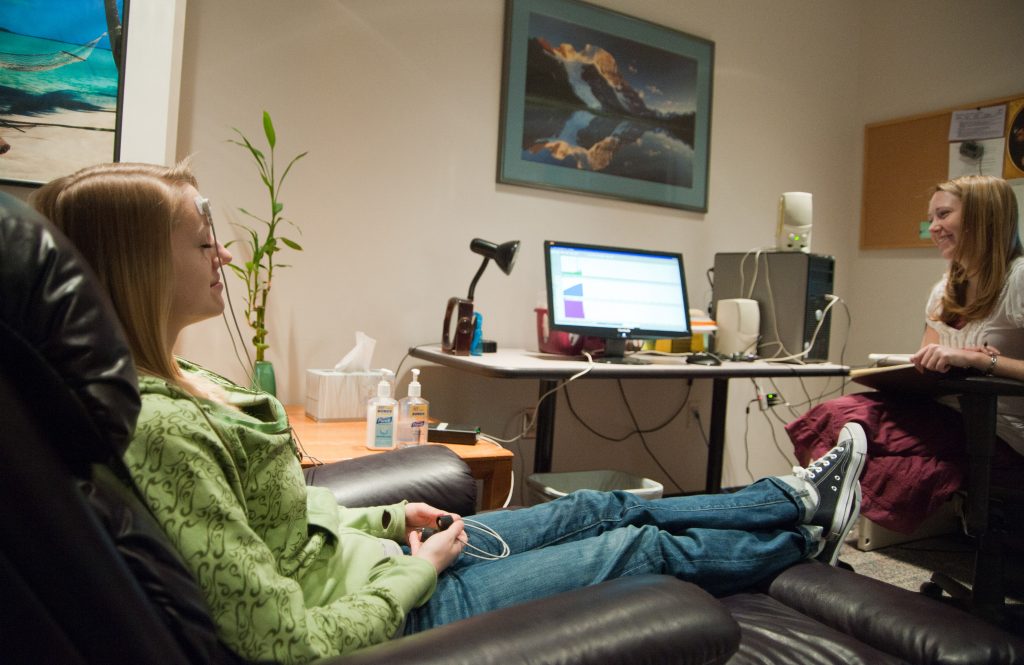
Managing stress can be as easy as counting to five, according to a BYU Education Week presentation by psychology professor Patrick R. Steffen.
Steffen spoke to a large crowd on Aug. 21, 2017 about self-regulation, or biofeedback, as a way to manage stress and to help prevent the effects of negative stress.
“Biofeedback is learning self-regulation, learning to be aware of what your body’s doing, and then changing that to the way you want it to be,” Steffen said.
According to Steffen, stress is an important part of our mental and physical health.
“The perception of high levels of negative stress predicts early death,” he said.
In a 2011 study on stress and its association with health and mortality, researchers found 55 percent of Americans report high levels of stress. According to Steffen and the study, the way stress is viewed can also contribute to increased mortality rates and other issues like high blood pressure and heart failure.
“So, if you perceive high levels of stress and you feel like you’re not able to cope with it, you’re in trouble,” Steffen said.
The good news is stress that isn’t perceived negatively does not affect a person’s health, according to Steffen.
He said the American Psychological Association publishes statistics about stress levels annually. Recent studies have shown stress is more likely to increase over the years than decrease.
“It’s usually money and relationships that give us a hard time,” Steffen said.
According to Steffen, not all stress is bad. For example, if someone were faced with a mountain lion, their stress response, or the “fight-or-flight” response in their body, would divert energy to the main muscle groups so they could run away from danger.
The problem arises when this response dictates daily stresses that aren’t life-or-death.
“To maintain ideal health, we can’t be in fight-or-flight, or freeze, all the time,” Steffen said. “It takes up energy to do this.”
He said people’s bodies move from a relaxed state to a tense state when they are in fight-or-flight mode, which affects some bodily functions, such as decreased saliva or tense muscles.
“If stress becomes chronic, the set point for heart rate, blood pressure, breathing, is set at a higher level,” Steffen said. “This is what wears our bodies out over time and leads to early death.”
One of the ways people can combat stress and the fight-or-flight response is through how they breathe, according to Steffen. People can learn through biofeedback exactly how their mindset can effect their breathing, heart rate and other physiological responses.
“In biofeedback, our goal isn’t to teach deep relaxation,” Steffen said. “Our goal is to teach balance so you can be calm and in the moment.”
“Low and slow breathing” is the best way to combat negative stress, according to Steffen.
“If you want to see the best way to breathe, watch how babies breathe,” he said.
Healthy breathing comes from the bottom of the lungs and moves the diaphragm and abdomen instead of the chest, according to Steffen.
“Interestingly, when you look at yogis, Sherpas and athletes, they naturally spend more time breathing at about six breaths per minute,” Steffen said.
These slower and more rhythmic breaths are what allow the body to gain more oxygen and help slow stress responses, according to Steffen.
Steffen said that breathing in for five seconds, then breathing out for five seconds, over the period of a few minutes a day, can help form healthy breathing habits through muscle memory.
“Breathe in through your nose and breathe out through your pursed lips, as if you’re blowing through a straw,” Steffen said.
He also said the best way to teach children how to regulate breathing is by having them blow bubbles.
At the end of his presentation, Steffen shared a few resources for biofeedback, including the apps My Calm Beat, Biobreathing, Breathe2Relax and Calm.com.




